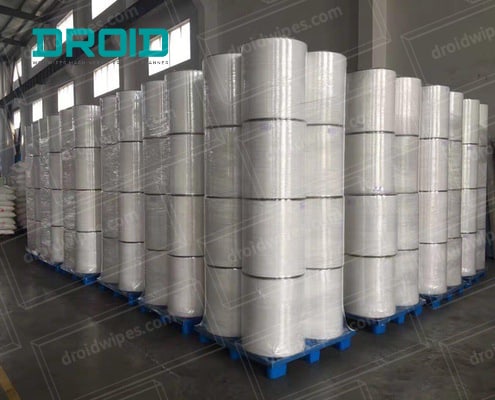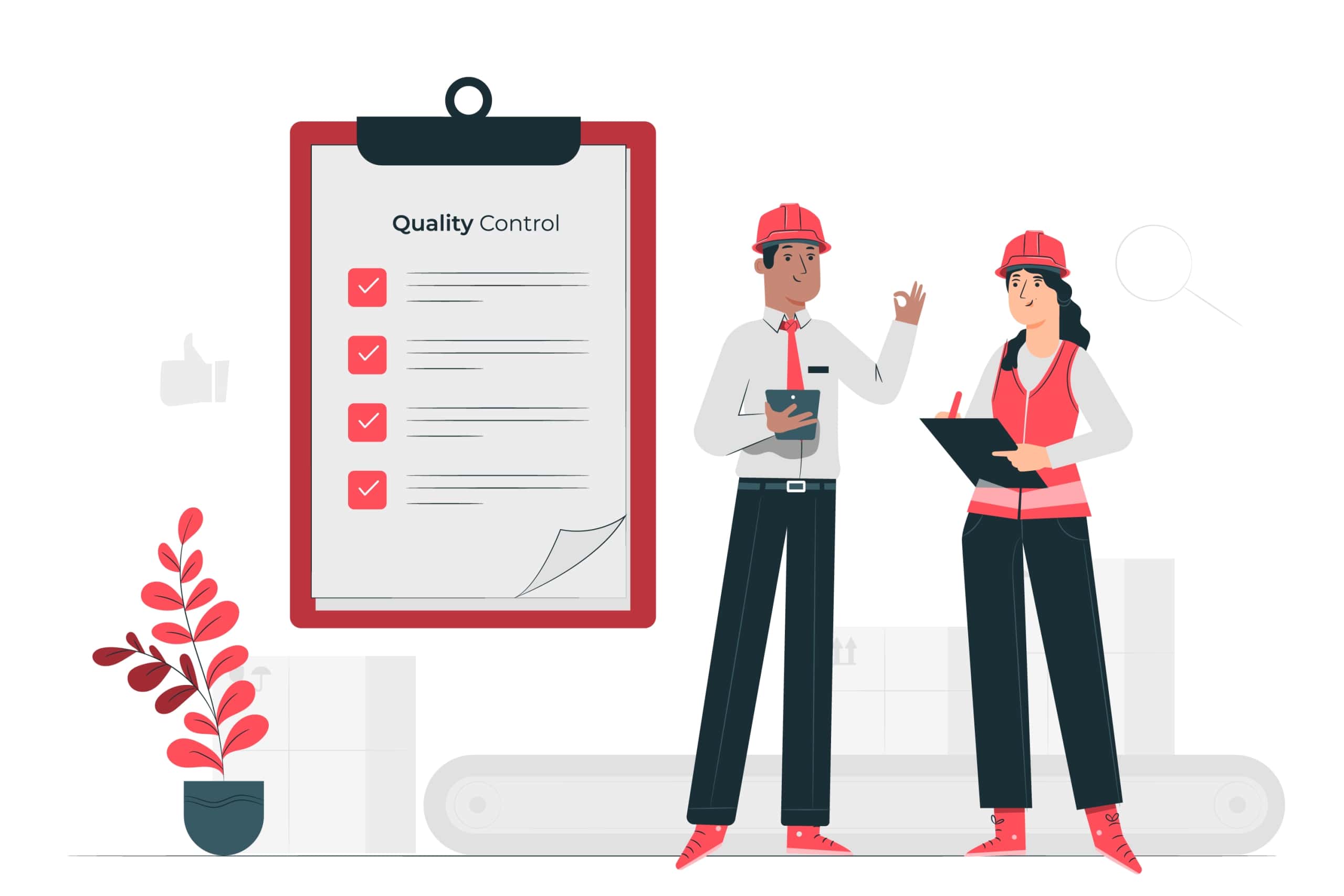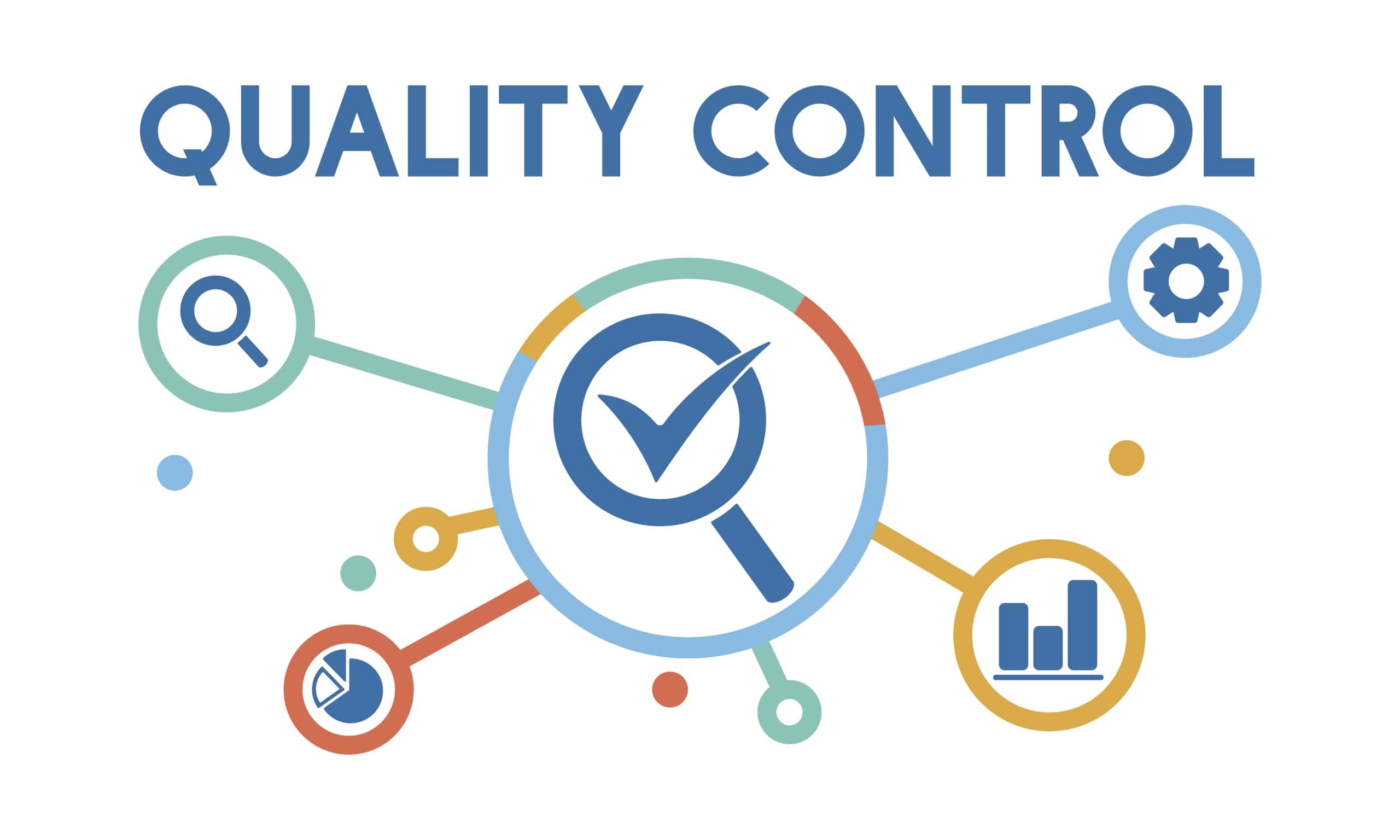1. Invest in High-Quality Raw Materials
The foundation of making exceptional wet wipes lies in the investment in top-notch raw ingredients. The wet wipes raw materials have a direct influence on the finished product, influencing its texture, efficacy, and overall user pleasure. To maintain the utmost quality, it is crucial to get raw materials from renowned suppliers that are recognized for their consistent and dependable performance. This entails establishing rigorous standards for suppliers, which include conducting frequent audits and quality inspections to ensure their compliance with the specified requirements and industry norms.
The essential components of high-grade raw materials for wipes are nonwoven fabric, cleaning solution, and other substances like moisturizers, perfumes, or preservatives. The nonwoven fabric must possess durability, softness, and absorbency to guarantee that the wipes are both gentle on the skin and efficient in their cleaning capabilities. The formulation of the washing solution should be designed to provide the desired advantages while minimizing the risk of irritation or negative responses. Wet wipes manufacturers may differentiate their wet wipes in a competitive market by giving priority to high-quality ingredients that fulfill customer expectations.
Furthermore, ensuring a steady supply of superior-grade raw materials aids in preventing interruptions in manufacturing. Cultivating robust partnerships with dependable suppliers may provide a consistent supply chain, mitigating the likelihood of scarcities or setbacks. Having numerous sources for each important commodity is advantageous as it offers a contingency plan in the event of unanticipated complications with one provider. This strategy not only ensures the high quality of the materials but also improves the overall stability and efficiency of the manufacturing process.
Investing in superior raw materials eventually results in increased consumer satisfaction and brand loyalty. Consumers are more inclined to have confidence in and repeatedly buy items that regularly fulfill their expectations about quality and performance. In addition, the use of high-quality wet wipes raw materials may enhance the brand’s image, establishing it as a dominant force in the business that is dedicated to providing top-notch goods. Over time, investing in quality yields benefits such as higher sales, favorable reviews, and a strong market reputation.
2. Regular Machine Maintenance and Calibration
Consistent wet wipes machine maintenance and calibration are essential for preserving the superior quality of your wet wipes manufacturing line. A production line that is well maintained operates with more efficiency and effectiveness, resulting in consistently improved output, much like a well-oiled machine. Enforcing a resilient maintenance program aids in averting unforeseen malfunctions and guarantees the best performance of all equipment components. This includes regular examinations, cleansing, application of lubricants, and prompt replacement of deteriorated components.
An effective maintenance approach starts by thoroughly knowing the wet wipes machine’s needs and following the wet wipes machine manufacturer’s guidelines. Create a comprehensive maintenance checklist that encompasses all crucial elements, including inspecting moving components for signs of deterioration, validating the proper functioning of sensors and automated systems, and confirming the presence and effectiveness of all safety features. Regularly planned maintenance not only prolongs the lifetime of the equipment but also aids in detecting possible faults before they develop into expensive repairs or production stoppages.
Calibration is an essential factor in ensuring constant quality in the manufacture of wet wipes. Over time, even highly advanced equipment may deviate from its initial configurations, resulting in discrepancies in the end output. Regular calibration guarantees that the equipment functions within the exact standards necessary for producing high-quality output. This procedure entails calibrating the machine settings to correspond with the predetermined values for every manufacturing cycle. Calibration should be performed by proficient specialists who possess the ability to precisely adjust the apparatus to preserve constant performance.
Consistent equipment maintenance and calibration are crucial for meeting industry standards and requirements. Complying with these standards not only prevents legal complications but also fosters confidence among consumers who depend on the excellence and safety of the items they use. Recording maintenance and calibration actions may serve as vital documentation for audits and quality assurance procedures, showcasing a dedication to upholding the utmost production standards.
Furthermore, equipment that is properly maintained and calibrated enhances the overall efficiency of manufacturing. Minimizing the amount of time that machines are out of operation owing to unforeseen malfunctions or quality control problems leads to increased efficiency and financial savings. Efficient machine operation enhances the predictability of the whole production process, enabling improved planning and allocation of resources. Enhanced efficiency may provide a competitive advantage in the market, allowing for quicker completion times and the capacity to satisfy increasing demand without sacrificing quality.
Ultimately, regular wet wipes machine maintenance and calibration are essential for guaranteeing constant and superior output in the manufacture of wet wipes. By using these strategies, wet wipes manufacturers may improve the dependability and durability of their equipment, ensure adherence to industry regulations, and ultimately produce goods that continuously surpass client expectations.
3. Implement Advanced Quality Control Systems
Implementing sophisticated quality control systems is crucial for upholding the elevated standards anticipated in the manufacture of wet wipes. These systems are specifically designed to oversee and track every step of the wet wipes manufacturing process, guaranteeing that every batch of wet wipes adheres to the necessary standards for quality, safety, and performance. Wet wipes manufacturers can rapidly discover and rectify possible problems, lowering the chance of defects and improving overall product quality by using advanced technologies such as sensors, cameras, and real-time data analytics.
An essential element of a sophisticated quality control system is the use of high-resolution cameras and sensors strategically placed at crucial locations along the manufacturing line. These machines perform continuous inspections on wet wipes to assess different quality characteristics, including thickness, size, moisture content, and texture. Any deviations from the established standards are promptly identified, enabling operators to promptly implement remedial measures before the goods progress further down the production process. The use of real-time monitoring guarantees that only items that satisfy the precise quality standards are allowed to proceed to the packing step.
Advanced quality control systems often include automatic feedback mechanisms with real-time monitoring. These mechanisms can dynamically modify machine settings depending on the data gathered during production. If a sensor detects that the moisture content in the wipes is below the acceptable level, the system may automatically make adjustments to the formulation or dispensing rate to fix the problem. This degree of automation not only improves uniformity but also decreases the need for manual interventions, thereby decreasing human mistakes.
Data analytics is essential in sophisticated quality control systems. Wet wipes manufacturers may detect underlying faults by evaluating data gathered from different sensors and inspection sites, allowing them to spot patterns and trends. By adopting a proactive approach, it becomes possible to use predictive maintenance strategies, which include identifying and resolving potential issues before they have a negative influence on output. For instance, if the data indicates a progressive deterioration in the functionality of a certain machine component, it may be promptly maintained or replaced to prevent a complete failure. This not only boosts the quality of the product but also improves the overall efficiency of operations.
Implementing sophisticated quality control systems also requires establishing extensive testing processes for the final items. Random samples from each batch may undergo thorough testing to guarantee compliance with all quality and safety criteria. These tests include the examination of microbiological contamination, pH levels, and compatibility with various skin types. Wet wipes manufacturers may demonstrate their dedication to quality by keeping meticulous records of these tests, which is crucial for adhering to regulations and gaining client confidence.
Moreover, sophisticated quality control systems enhance the process of continuous improvement by offering useful insights into the manufacturing process. The acquired data may identify specific areas for potential enhancements, such as optimizing machine configurations, improving operator training, or refining the selection of wet wipes raw materials. Through ongoing analysis and enhancement of the wet wipes manufacturing process, wet wipes manufacturers may maintain a competitive edge and continually provide wet wipes of superior quality that meet or surpass consumer expectations.
Ultimately, the use of sophisticated quality control systems is an essential approach to guaranteeing uniform quality in the production of wet wipes. These technologies provide immediate monitoring, automatic modifications, and thorough data analytics, allowing wet wipes manufacturers to immediately identify and resolve difficulties, maintain high standards, and constantly enhance their operations. Wet wipes manufacturers may improve product dependability, customer happiness, and overall market competitiveness by investing in modern quality control.
4. Training and Development of Operators
Ensuring the proficiency and growth of operators is essential for sustaining superior output in the manufacture of wet wipes. Proficient operators who possess a deep understanding of the complexities of the production equipment and quality control procedures are very significant assets to any manufacturing plant. By investing in thorough training programs, operators may acquire extensive knowledge and skills in machine operations, troubleshooting, and maintaining quality standards. This, in turn, leads to a more efficient and dependable production process.
First and foremost, the first training sessions should include the essential components of running wet wipes technology. This entails comprehending the many constituents of the machine, its functionalities, and the accurate protocols for initiating, functioning, and ceasing the apparatus. Operators should get training in recognizing and resolving typical difficulties that may occur during production. Operators may enhance their understanding of these principles more efficiently via a combination of practical training, comprehensive instructional manuals, and visual aids.
In addition to fundamental knowledge, ongoing training and development are crucial to ensure that operators stay informed about the most recent innovations in technology and production methods. The wet wipes manufacturing sector is continuously advancing, with frequent introductions of new technology, automation tools, and quality control systems. Consistent training sessions and seminars may assist operators in staying up-to-date with these advancements, guaranteeing their ability to use the most recent technologies to uphold and enhance product quality.
Moreover, operators must undergo specialized training to acquire essential knowledge and skills in quality control methods. They must comprehend the precise quality criteria that wet wipes must meet, which include factors such as moisture content, texture, and package integrity. Training should include the use of quality control instruments and systems, such as sensors and cameras, in addition to methods for conducting human inspections. Operators must possess a high level of proficiency in identifying flaws and comprehending the suitable measures to be taken in response to deviations.
Another crucial element of operator training is cultivating a culture that prioritizes safety and compliance with regulatory requirements. Operators are required to undergo training on safety measures to avoid accidents and maintain a secure working environment. This includes the proper use of personal protective equipment (PPE), the secure manipulation of raw materials and chemicals, and the implementation of emergency response protocols. Adhering to industry norms and standards is not only a legal obligation but also a crucial aspect of maintaining product quality and safeguarding the company’s brand.
Promoting a culture of ongoing improvement among operators may greatly boost the quality of output. Operators who possess a strong drive to recognize and execute enhancements can enhance efficiency and uniformity in the wet wipes manufacturing process. Facilitating avenues for operators to propose enhancements, partake in troubleshooting groups, and partake in ongoing education may result in beneficial breakthroughs and heightened work contentment.
Moreover, using resources to enhance the professional growth of operators might result in improved employee retention and a highly proficient staff. Providing career progression prospects, such as certifications, advanced training programs, and leadership development, may incentivize operators to remain with the organization and improve in their positions. An adept and seasoned team of operators has the potential to substantially minimize downtime, enhance productivity, and maintain exemplary levels of quality.
Ultimately, the training and development of operators play a crucial role in attaining a constant level of quality in the manufacture of wet wipes. Wet wipes manufacturers can guarantee that their operators maintain high levels of quality and efficiency by offering thorough initial training, ongoing education on the newest technologies and quality control procedures, and promoting a culture of safety and continuous development. Investing in operator training not only improves the dependability of products, but also fosters a safer, more motivated, and more proficient staff.
5. Optimize Production Parameters
Optimizing production parameters is an essential technique for guaranteeing the constant quality and efficiency of wet wipes manufacturing. Adjusting the many parameters of your manufacturing equipment may have a substantial influence on the quality of the end product, including its texture, moisture level, and general efficiency. Wet wipes manufacturers may optimize the quality of their goods by precisely manipulating factors such as speed, pressure, temperature, and formulation ratios.
Before improving production parameters, it is essential to carry out comprehensive testing and analysis. This entails doing a sequence of experimental runs to determine the most effective configurations for manufacturing each variant of wet wipes. The optimal manufacturing parameters may be influenced by variables such as the nonwoven fabric type, the composition of the washing solution, and the intended application of the wipes (e.g., baby wipes, disinfection wipes, cosmetic wipes). Comprehensive documentation of these trials is crucial since it serves as a guide for configuring the gear for future production runs.
Velocity is a crucial factor that might impact the quality of moist towelettes. Although faster speeds might enhance manufacturing productivity, they can also result in product irregularities, such as uneven distribution of moisture or inadequate sealing. It is crucial to achieve the optimal equilibrium between velocity and excellence. Operators must calibrate the machine speed to guarantee that the wipes are evenly soaked and properly folded and packed, thereby preserving the integrity of each wipe.
It is crucial to take into account the pressure settings, especially during the sealing and cutting phases. The pressure must be enough to establish a reliable seal without compromising the integrity of the wipes or resulting in any leakage. During the cutting phase, it is essential to ensure that the blades are both sharp and properly adjusted to the appropriate pressure. This will result in precise and neat edges while preventing any fraying of the material. Consistently achieving desired outcomes may be facilitated by regularly calibrating and maintaining the cutting and sealing systems.
Optimizing production parameters requires careful management of temperature control. Accurate calibration of the temperature settings is necessary to provide robust and airtight seals throughout the sealing process while maintaining the material’s integrity. Temperature regulation during the formulation mixing process may have an impact on the solubility and stability of the active components in the washing solution. Ensuring consistent temperature control is crucial for preserving the quality and efficacy of the end product.
The formulation proportions of the washing solution are equally significant. Precise measurement and blending of the active components, water, and other substances guarantee that every wipe provides the desired advantages, whether it is for cleansing, disinfecting, or moisturizing. Automated dosing systems may assist in attaining accurate formulation ratios, reducing the probability of human mistakes, and guaranteeing constant product quality.
Deploying sophisticated monitoring systems may significantly enhance the optimization of production parameters. By using sensors and real-time data analytics, operators may get ongoing input on the manufacturing process, enabling them to promptly make necessary modifications. If a sensor detects that the moisture content in the wipes is not within the specified range, the system may automatically modify the rate at which the solution is dispensed. By using this degree of automation, manufacturing parameters are continually fine-tuned, leading to the manufacture of superior-quality goods.
Consistently enhancing and periodically evaluating production parameters are crucial for sustaining peak performance. Periodic re-evaluation of the settings is necessary due to potential changes in production circumstances and raw material characteristics. Promoting the practice of operators promptly reporting any deviations or problems they come across may result in timely modifications and enhancements. Moreover, staying updated on technical developments and industry best practices may provide fresh perspectives on enhancing manufacturing operations.
To summarize, the continuous and dynamic optimization of production parameters is crucial in the manufacturing of wet wipes of superior quality. Wet wipes manufacturers may attain consistent and dependable product quality by meticulously controlling and observing speed, pressure, temperature, and formulation ratios. Utilizing sophisticated monitoring systems and promoting a culture of ongoing improvement further improves the efficiency and effectiveness of the manufacturing process. By carefully adjusting production parameters, wet wipes manufacturers may satisfy client demands and retain a competitive advantage in the market.
6. Implement a Robust Monitoring and Feedback System
Establishing a strong monitoring and feedback system is crucial for sustaining elevated levels of quality and efficiency in the production of wet wipes. This system guarantees the ongoing monitoring and assessment of every component of the wet wipes manufacturing process, allowing the timely identification and rectification of any deviations from the established criteria. Wet wipes manufacturers may have enhanced control over their operations, resulting in consistent product quality and higher operational efficiency, by using cutting-edge technology and real-time data analytics.
An all-encompassing monitoring system incorporates diverse sensors, cameras, and automatic feedback systems throughout the manufacturing line. These devices consistently gather data on essential characteristics such as moisture content, fabric integrity, formulation correctness, and packaging quality. For example, advanced cameras with high resolution may collect photographs of the wipes throughout various phases of manufacturing, enabling thorough inspection and prompt detection of any flaws. Sensors are capable of monitoring several factors, including temperature, pressure, and speed, to ensure that they stay within the appropriate range.
Real-time data analytics is an essential element of a strong monitoring system. Wet wipes manufacturers may get useful insights into the manufacturing process by examining the data gathered by sensors and cameras. This study facilitates the identification of patterns and trends that may signify prospective concerns, such as the progressive deterioration of equipment or variations in the quality of raw materials. Predictive analytics may also be used to anticipate and predict possible issues before they have an influence on production, enabling proactive maintenance and changes.
Automated feedback methods are essential for rapidly addressing any deviations from the required criteria. These methods can autonomously modify machine configurations in response to the real-time data gathered. For instance, if the system identifies that the moisture level in the wipes is insufficient, it may autonomously enhance the pace at which the washing solution is dispensed. By implementing this prompt adjustment, it is possible to preserve the uniformity and excellence of the product without requiring any personal involvement.
Furthermore, a comprehensive monitoring system should have a transparent and streamlined communication protocol for operators and management, in addition to automated feedback. Operators may get real-time warnings and messages when deviations are identified, allowing them to promptly take remedial steps. Comprehensive reports and dashboards may provide management with a comprehensive perspective of production performance, pinpointing areas for improvement and guaranteeing continual adherence to quality standards.
Regular audits and evaluations of the monitoring system are crucial to guarantee its efficacy. Regular assessment of the system’s performance aids in identifying any deficiencies or vulnerabilities that need attention. Enhancing the capabilities of the monitoring system may be achieved by incorporating the latest technical breakthroughs and using industry best practices. It is essential to provide training to operators and staff on how to proficiently use the monitoring tools and accurately analyze the data to fully optimize the system’s advantages.
The implementation of a strong monitoring and feedback system is crucial for ensuring regulatory compliance and maintaining high-quality standards. Comprehensive documentation of the monitoring data may serve as proof of adherence to industry norms and laws. This paperwork is crucial for audits and has the potential to improve the credibility and reputation of the manufacturing plant. Customers may have confidence in the constant high quality of the items they get since the manufacturing process is closely checked and managed.
Furthermore, a strong monitoring and feedback system facilitates ongoing improvement efforts. Wet wipes manufacturers may uncover chances for process improvement and innovation by consistently examining the data and comments. Adopting this proactive strategy results in increased efficiency in manufacturing procedures, less waste, and reduced operating expenses. Additionally, it promotes a culture of ongoing refinement, whereby operators and management are motivated to actively pursue and apply improvements to the production process.
Ultimately, including a strong monitoring and feedback system is a crucial approach to guaranteeing steadfast quality and effectiveness in the production of wet wipes. Wet wipes manufacturers may get enhanced operational control by using cutting-edge technologies, real-time data analysis, and automated feedback systems. This all-encompassing strategy not only improves the quality of the product and ensures compliance with regulations, but also promotes ongoing improvement and operational excellence. By consistently monitoring and providing prompt feedback, producers can uphold stringent standards and fulfill the constantly changing requirements of the market.
7. Focus on Environmental Control
Emphasizing environmental management in the manufacturing facility is crucial for guaranteeing the constant quality of wet wipes. The quality and safety of the finished product may be greatly influenced by the production environment since parameters such as humidity, temperature, air quality, and cleanliness are crucial. Enforcing strict environmental control measures improves manufacturing conditions, leading to increased product integrity and dependability.
An essential component of environmental control is the regulation of humidity levels. Excessive humidity might impact the moisture level of the wet wipes, resulting in either too saturated or insufficiently moist items. Both situations may undermine the efficacy and attractiveness of the wipes. By strategically placing dehumidifiers and humidity sensors throughout the production area, it becomes possible to achieve accurate regulation and surveillance of moisture levels. This ensures that the moisture levels consistently stay within the ideal range, hence guaranteeing constant product quality.
Temperature regulation has comparable significance inside the production setting. Temperature fluctuations might affect the stability of the washing solution and the functioning of the apparatus. For example, certain components in the mixture may lose their effectiveness or separate when exposed to high temperatures, while equipment may not function optimally under severe circumstances. Ensuring a consistent and reasonable temperature in the production area is essential for maintaining the effectiveness of the active ingredients and promoting efficient machine operations. One may do this by using temperature control systems, such as heating, ventilation, and air conditioning (HVAC) devices.
Air quality is a vital determinant in environmental management. Contaminants, including dust, microorganisms, and chemical vapors, have the potential to undermine the cleanliness and safety of wet wipes. By using high-efficiency particulate air (HEPA) filtering devices and ensuring positive air pressure in cleanroom settings, the potential for contamination may be greatly reduced. Regular evaluations of air quality and consistent upkeep of air filtration systems are crucial practices to guarantee a sanitary production environment.
Strict adherence to cleanliness and hygiene standards is required throughout the manufacturing plant. This entails routine cleaning and sanitization of all equipment, surfaces, and production locations to prevent microbiological infection. Implementing stringent guidelines for personal hygiene, such as mandating the use of protective attire, hairnets, and gloves, significantly reduces the likelihood of contamination. It is crucial to ensure that the cleaning agents and disinfectants used in the manufacturing environment are suitable and do not leave any dangerous residues.
Implementing environmental control measures necessitates the monitoring and management of possible sources of pollution. This encompasses the regulation of the entrance and egress of individuals and resources inside the manufacturing zone. Only authorized workers should be allowed to access key production zones, and all items brought into the cleanroom must undergo rigorous inspection and sanitization. Implementing airlocks and air showers at entrance points may effectively minimize the introduction of pollutants.
Furthermore, it is important to include environmental control systems in the comprehensive quality management framework of the production plant. Consistently observing and recording environmental factors yields vital information for ensuring quality and adhering to regulations. Advanced monitoring systems can promptly notify users if any environmental parameters vary from the established norms, enabling urgent remedial measures to be taken. This integration guarantees that environmental control is a continuous and flexible process that adjusts to the evolving circumstances and requirements of the industrial environment.
By prioritizing environmental control, not only can the quality and safety of the wet wipes be guaranteed, but it may also improve the overall efficiency of the manufacturing process. A well-regulated environment helps to mitigate the possibility of production interruptions caused by external sources and also decreases the amount of waste resulting from product imperfections. As a result, there are financial benefits and improved efficiency. In addition, upholding stringent environmental standards enhances the credibility and standing of the production facility by showcasing a dedication to providing top-notch, secure goods.
Ultimately, prioritizing environmental control is an essential approach to preserving the quality and uniformity of wet wipes throughout the production process. Wet wipes manufacturers may establish ideal manufacturing conditions by carefully controlling humidity, temperature, air quality, and cleanliness. This all-encompassing strategy guarantees the honesty and security of the result, upholds adherence to regulations, and improves operational effectiveness. By implementing rigorous environmental control measures, wet wipes manufacturers can satisfy the elevated expectations of customers and retain a competitive advantage in the market.
8. Leverage Automation for Precision
Utilizing automation in the manufacture of wet wipes is a crucial approach to guaranteeing consistent quality, improving productivity, and minimizing human error. Automation incorporates cutting-edge technology like robots, sensors, and artificial intelligence into the manufacturing process, allowing for meticulous control over all aspects of production. Through the use of automation, producers may attain elevated levels of precision and consistency, resulting in enhanced product quality and operational superiority.
Automation offers a significant advantage by enhancing the accuracy of the wet wipes manufacturing process. Automated systems can execute tasks with a degree of precision that is difficult to attain by human means. Automated dispensers provide precise application of the appropriate quantity of washing solution to every wipe, hence ensuring constant moisture levels across all products. Robotic arms can fold, cut, and package wipes with exceptional accuracy, guaranteeing consistency and minimizing wastage.
Automation greatly improves the speed and efficiency of the manufacturing process. Automated equipment can function without experiencing weariness, resulting in increased output rates and decreased periods of inactivity. Enhanced efficiency enables wet wipes manufacturers to fulfill more demand and reduce delivery times, resulting in a competitive edge in the market. In addition, automation can enhance productivity by removing obstacles and efficiently using resources, resulting in streamlined processes.
Automation offers a significant benefit by minimizing human mistakes. Manual procedures are prone to irregularities and errors, which may undermine the quality of the result. Wet wipes manufacturers may mitigate these risks by automating monotonous and intricate activities. Automated systems are designed to adhere to specific instructions and maintain a constant level of performance, guaranteeing that each product fulfills rigorous quality requirements. The dependability of wet wipes is crucial for preserving their quality since even little variances might impact the efficacy and consumer satisfaction of the product.
Advanced automation technologies provide the ability to monitor and receive feedback in real time. Sensors and data analytics tools can continually monitor and analyze production factors, including speed, temperature, pressure, and moisture content. The real-time data gathering enables instant identification of any deviations from the established norms. Subsequently, automated systems can adapt the production settings in real time to rectify any variations, so guaranteeing uniform quality across the whole manufacturing process. Having a high degree of control and reactivity is crucial to maintaining the required high standards in the manufacture of wet wipes.
Furthermore, automation enhances the efficiency of data administration and enables improved traceability. Automated systems provide comprehensive records of the manufacturing process, gathering data on every batch manufactured. This information is very essential for ensuring the quality of products, complying with regulations, and making ongoing improvements. Through the analysis of this data, producers may discern patterns, precisely identify regions that need improvement, and efficiently execute remedial measures. Enhanced accountability and transparency are crucial for establishing confidence with customers and regulatory agencies, and the ability to track the manufacturing history of each batch contributes to this.
Introducing automation in the production of wet wipes also promotes a more secure working environment. Automated systems are capable of doing activities that require significant physical effort, repeated actions, or contact with dangerous chemicals, hence minimizing the likelihood of workplace accidents. By implementing this measure, not only will the health and safety of workers be safeguarded, but it will also boost morale and productivity. Moreover, automation may contribute to the upkeep of a more hygienic manufacturing setting by eliminating the interaction between humans and raw materials or completed goods, thereby reducing the likelihood of contamination.
To achieve effective implementation and get the most advantages, investing in automation requires a planned strategy. Wet wipes manufacturers want to do a comprehensive evaluation of their existing manufacturing processes to pinpoint the areas where automation might provide the most substantial influence. Collaborating with proficient automation solution wet wipes manufacturers may assist in choosing the appropriate technologies and effortlessly incorporating them into the current production line. Training and development programs for operators and technicians are crucial to ensure their ability to proficiently oversee and maintain the automated systems.
To summarize, using automation in the production of wet wipes is an effective approach to ensure accuracy, improve productivity, and minimize mistakes caused by human involvement. Wet wipes manufacturers may attain greater levels of precision, velocity, and dependability by incorporating cutting-edge technology into the manufacturing process. Automation enhances both the quality of products and the efficiency of operations, while also facilitating improved data management, traceability, and worker safety. By strategically implementing and consistently improving automation, the wet wipes sector may gain a substantial competitive advantage.
9. Develop a Comprehensive Quality Assurance Program
Establishing a thorough quality assurance (QA) program is crucial for upholding the stringent standards necessary in the production of wet wipes. An extensive quality assurance program covers every stage of the manufacturing process, starting with the acquisition of raw materials to the final testing of the product. This program guarantees that each product fulfills the high standards of quality and safety that customers and regulatory agencies need. Wet wipes manufacturers may attain consistent product quality and cultivate a reputation for dependability and excellence by implementing explicit norms, thorough testing processes, and ongoing monitoring.
An effective QA program is built upon rigorous raw material selection and supplier management. Acquiring top-notch raw materials from trustworthy suppliers that adhere to the requirements and standards is of utmost importance. This entails doing periodic supplier audits, defining explicit quality standards, and cultivating enduring partnerships with reliable vendors. Wet wipes manufacturers may avoid quality difficulties in the wet wipes manufacturing line by ensuring that the wet wipes raw materials adhere to the highest requirements.
After obtaining the necessary raw materials, the subsequent stage involves implementing stringent quality control methods throughout the wet wipes manufacturing process. This entails ongoing surveillance and examination at different points of the manufacturing process to guarantee that every stage adheres to the predetermined quality standards. During the process of combining the washing solution, it is essential to ensure accurate measures and thorough blending to preserve uniformity. Likewise, the nonwoven fabric must undergo an examination to ensure consistency and soundness before being transformed into wipes. Wet wipes manufacturers may avoid faults and maintain product quality by promptly detecting and resolving difficulties at the beginning of the process.
Conducting final product testing is an essential element of the quality assurance (QA) procedure. It is necessary to subject random samples from each batch to thorough testing to confirm their compliance with all quality and safety criteria. These tests may include examinations for microbiological contamination, pH levels, moisture content, and compatibility with various skin types. In addition, the wipes undergo physical testing, including assessments of tensile strength, absorbency, and package integrity, to verify that they meet the intended performance standards. Comprehensive records of these tests provide vital documentation for adhering to regulations and assuring customers.
An all-encompassing quality assurance program also includes establishing a methodical process for managing instances of non-compliance and consumer grievances. Implement explicit protocols for recognizing, recording, and resolving any deviations from the established quality benchmarks. Implement corrective and preventative actions (CAPA) to address and prevent the reoccurrence of problems. Implementing this proactive strategy not only enhances the quality of the product but also shows a dedication to always improving and satisfying customers.
The QA program’s performance relies heavily on the training and development of workers. Operators, technicians, and quality control professionals should possess comprehensive training in QA processes and have a clear understanding of the significance of their responsibilities in upholding quality standards. Consistent training sessions, seminars, and refresher courses may ensure that the team is well-informed on the most current quality control procedures and industry-leading practices. Promoting a culture that emphasizes the importance of quality awareness and accountability guarantees that all individuals within the business are dedicated to attaining and maintaining elevated standards.
Incorporating cutting-edge technology into the quality assurance (QA) program may greatly improve its efficiency. Automated quality control systems, real-time data analytics, and digital documentation tools can optimize QA procedures and provide more precise and dependable outcomes. By using high-resolution cameras and sensors, problems that may elude human inspection may be identified via real-time inspection. Data analytics may facilitate the identification of trends and patterns, allowing better-informed decision-making and fostering ongoing development.
Periodic evaluations and inspections of the quality assurance program are essential to guarantee its ongoing efficiency and pertinence. Regular assessments may assist in identifying areas for improvement and guaranteeing that the quality assurance procedures are in line with current regulatory mandates and industry benchmarks. Hiring external auditors or consultants may give an impartial evaluation of the QA program and make helpful suggestions for improvement.
To summarize, establishing a thorough quality assurance program is an essential approach to guaranteeing uniform quality in the production of wet wipes. Wet wipes manufacturers may establish a reputation for dependability and excellence by employing stringent quality control systems, comprehensive testing processes, and ongoing monitoring. The QA program is reinforced by personnel training and development, the use of sophisticated technologies, and frequent evaluations and audits. By implementing a methodical and preemptive strategy for quality assurance, businesses may satisfy consumer demands, adhere to regulatory standards, and achieve sustained success in the fiercely competitive wet wipes industry.
10. Engage in Continuous Improvement
Participating in ongoing development is a vital tactic for preserving and improving the quality and efficiency of wet wipes production. Continuous improvement is a persistent endeavor to recognize, examine, and execute gradual modifications that result in enhanced performance, superior quality goods, and heightened operational efficiency. By using this proactive strategy, enterprises may maintain their competitiveness, fulfill changing client demands, and adjust to market and technological advancements.
The cornerstone of continuous improvement is in the dedication to consistently appraise and scrutinize every facet of the manufacturing process. This is the gathering and examination of data from different phases of the production process to pinpoint areas that may be improved. Key performance indicators (KPIs) such as production velocity, defect rates, downtime, and customer feedback provide significant insights into the efficiency of existing operations. Through a methodical examination of these variables, wet wipes manufacturers may identify inefficiencies and develop plans to rectify them.
Employee engagement is crucial for achieving effective and ongoing development. Operators, technicians, and other personnel who are actively engaged in the wet wipes manufacturing process often possess significant perspectives on prospective enhancements. Establishing a culture that promotes workers’ willingness to express their ideas and actively engage in problem-solving projects cultivates a feeling of responsibility and ownership. Regular sessions of collaborative idea generation, programs for soliciting suggestions, and teams composed of individuals from different departments may facilitate the creation of novel solutions and propel ongoing efforts for improvement.
By adopting a methodical approach to ongoing enhancement, such as Lean manufacturing or Six Sigma, organizations may establish a structured framework to systematically identify and eliminate inefficiencies, minimize variations, and enhance process effectiveness. Lean principles prioritize the creation of customer value by removing tasks that do not add value and improving processes. Methods such as value stream mapping, 5S, and kaizen may optimize manufacturing processes and improve overall efficiency. The use of Six Sigma approaches, which prioritize the use of data-driven decision-making and statistical analysis, may effectively minimize faults and enhance the overall quality of products.
Technology plays a crucial role in facilitating continual improvement activities. Advanced manufacturing technologies, including as automation, real-time monitoring systems, and data analytics, empower producers to enhance accuracy and exert more control over the production process. Automated quality control systems can identify and rectify deviations in real-time, therefore guaranteeing consistent product quality. Data analytics can reveal patterns and trends that may not be easily seen via human observation. This allows for better-informed decision-making and targeted improvements.
Consistent training and development programs are essential for cultivating a culture that consistently strives for progress. Providing staff with regular updates on the most recent industry trends, technology, and best practices guarantees that they possess the necessary knowledge and abilities to make valuable contributions to improvement projects. Providing avenues for professional growth, including certifications, courses, and seminars, may also inspire staff and bolster their dedication to excellence and innovation.
Continuous improvement encompasses not just internal procedures, but also requires vigilance towards external elements such as market trends, consumer preferences, and regulatory changes. Consistently collecting and evaluating consumer feedback aids producers in comprehending their requirements and expectations, empowering them to implement modifications that improve customer contentment. Gaining insights and inspiration for fresh improvement ideas may be achieved by monitoring industry trends and actively engaging in trade exhibitions, conferences, and professional networks.
To maintain ongoing improvement initiatives, it is crucial to construct a feedback loop that monitors the influence of made modifications and evaluates their efficacy. Conducting regular audits and assessments of improvement projects is crucial to verify their effectiveness and discover further chances for improvement. Recording achievements and insights may serve as a significant point of reference for future endeavors aimed at enhancing performance.
Ultimately, actively pursuing ongoing improvement is an essential approach for attaining and maintaining exceptional benchmarks in the production of wet wipes. Wet wipes manufacturers may achieve continuous improvements in quality and efficiency by frequently evaluating processes, engaging personnel, using systematic approaches, utilizing technology, and being aware of external influences. By always striving for improvement, wet wipes manufacturers may effectively address the changing needs of the market, boost customer happiness, and ensure lasting success.










